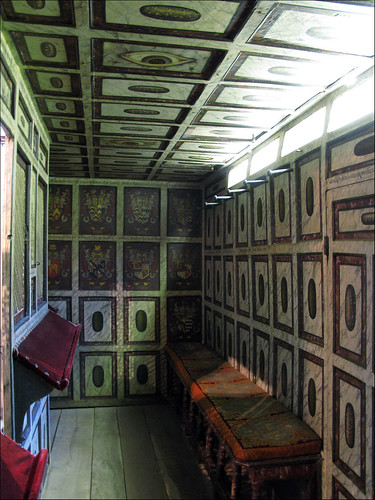Even though she's much shorter than I am, "Sister X" is someone I really look up to. Now in her 80's, hers has not been an easy life, having suffered many trials and family tragedies. But through it all she has never complained. Many admire how she has faithfully hung in there, a great example of what the Lord expects us to be -- a faithful friend, kind, charitable, willing to serve anywhere the Lord asks. Her life shows she takes seriously the words of our 13th Article of Faith: "We hope to be able to endure all things" -- with one exception: She cannot endure it when someone sits in her spot in the chapel.
"Sister X" is not alone. Many there are who act as if the seats they claim as their own were earned through their faithfulness in the pre-existence. To be forced to sit somewhere else is tantamount to asking Queen Elizabeth to carry her own luggage! Inconceivable!
Members who stake a claim to certain pews bring back memories of a college class where we studied the practices of churches in the 1700's. To help defray the costs of building a church, the more well-to-do could contribute a sizable sum, and in return they'd be allowed access to their exclusive "family pews," many of their own design. One of the benefits, of course, was that they'd be guaranteed to sit in the same spot week after week.
The more conservative ones looked something like this -- a simple enclosure with a door on the end.

St. Margaret's Church, Felbrigg (Photo by Derek Lamden)
But this was nothing when compared to many parish churches in England. Some of those pews had backs so high nobody could see you. They gave their owners total privacy, some with curtains and high, ornately carved walls. Your neighbors couldn't tell whether you were awake or not!
Here are some examples:

Ferneley Family Pew, 1828.

Barnardiston Family Pew, Sts. Peter and Paul, Kedington, assembled in 1610 from pieces of the medieval screen that once separated the Holy of Holies from the rest of the church, but dissembled for the more fitting purpose of constructing a private sitting place for Important Persons.


Interior of Kederminster Family Pew, decorated with coats of arms, and containing hat pegs and benches.
(The preceding 4 examples, including captions, were found on http://laudemgloriae.blogspot.com/2009/11/family-pew.html )
These photos call to mind a 1955 article about reverence in church meetings by President David O. McKay. Commenting on the rudeness of young people who leave church meetings before dismissal, he said, "They should have lived in colonial days when just to make sure they stayed through the service young men were locked in their pews by their superiors."
Christopher Wren, one of the most highly acclaimed architects in all of England and the designer of famous cathedrals and palaces, hated the notion of family pews which afforded fashionable privileges to the rich, leaving standing room only or limited space in the upstairs galleries for the poor. After all, he reasoned, the gospel should be available to all without class distinction. Eventually the practice was discontinued.
Christopher Wren, one of the most highly acclaimed architects in all of England and the designer of famous cathedrals and palaces, hated the notion of family pews which afforded fashionable privileges to the rich, leaving standing room only or limited space in the upstairs galleries for the poor. After all, he reasoned, the gospel should be available to all without class distinction. Eventually the practice was discontinued.
But back to our day. I cannot deny that sitting in the same place every week lends continuity and stability to our Sunday worship. But seriously, folks -- can we really feel justified in reacting in red-hot anger when a stranger "jumps our claim"? Or refusing to budge when they ask that we (gasp!) move to the center of the pew?
Our tithes and offerings do not guarantee season tickets. Let us walk the charitable walk and not just talk the talk.

No comments:
Post a Comment